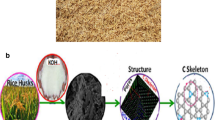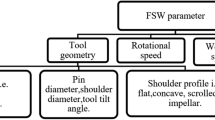Abstract
In this study, the optimum process parameters for the manufacture of brake friction linings (BFLs) from palm kernel shells (PKS), periwinkle shells (PWS), and coconut shell (CNS) composites were established using signal–to–noise ratio based on the Taguchi technique. The L9(34) orthogonal array was set up for the investigation of the performance metrics (coefficient of friction, wear rate, and hardness) synergized by multiple criteria evaluation. The manufacturing parameters considered were molding pressure, molding temperature, curing time, and heat treatment time. Consequently, the optimized parameters were utilized for the production of different BFL composites of the PKS/PWS/CNS mix. Finally, entropy and TOPSIS techniques were employed to isolate the best composite for comparative analysis. The results show that the optimum process parameters are 29 MPa (molding pressure), 120 °C (molding temperature), 6 min (curing time), and 2 h (heat treatment time). ANOVA using Minitab 21.1.0.0 shows that the effects of the molding pressure and curing time are statistically significant at α = 0.05, with a total contribution of 94.45%. The entropy-TOPSIS analysis gave sample S2pkpc with a composition of 12% PKS, 15% PWS, and 18% CNS as the best composite. Compared to the asbestos BFL, the composite shows an improvement in friction coefficient (45.7%), wear rate (66%), density (60.2%), and oil and water absorption (233%) (542.8%) respectively. The live test on a Peugeot 301 using S2pkpc BFL confirms the satisfactory performance of the composite. However, an increased wear rate was observed at vehicle speeds above 90 km/h.












Similar content being viewed by others
Data availability
The data used to support the findings of this study are available from the corresponding author upon a reasonable request.
References
Anbalagan R, Jancirani J, Venkateshwaran N (2013) Design and modification of vacuum braking system. Int J Eng Res Appl 2(3):907–916
Ibhadode AO, Dagwa IM (2008) Development of asbestos-free friction lining material from palm kernel shell. Journal of the Brazilian Society of Mechanical Science and Engineering 30(2):166–173
Amaren GS (2016) Development of automobile disk brake pads using eco-friendly periwinkle shell and fan palm shell materials. Dissertation, Ahmadu Bello University Zaria
Aigbodion VS, Akandike SB, Hassan FA, Agunsoye JO (2010) Development of asbestos-free brake pad using bagasse. Tribology in Industry 32(1):12–18
Mohammed TI, Ojo OO, Kaffo OP (2017) Development of eco-friendly automobile brake pad using different grade sizes of palm kernel shell powder. Current Journal of Applied Science and Technology 23(2):1–14
Abutu J, Lawal SA, Ndaliman MB, Lafa-Araga RA, Adedipe O, Choudhury IA (2019) Production and characterization of brake pad developed from coconut shell reinforcement material using central composite design. SN. Appl Sci 1(82). https://doi.org/10.1007/s42452-018-0084-x
Bashar D, Peter BM, Joseph M (2012) Effect of material selection and production of a cold-worked composite brake pad. Journal of Engineering of Pure and Applied Sciences 2(3):154
Orumwense F, Abhulimen E (2017) Characterization and development of asbestos free brake pad using snail shell and rubber seed husk. African Journal of Engineering Research 5:24–34
Soundararajan R, Karthik S, Ashoka PV, Achith AD, Venkat MB, Sharath PN, Sivaraman S (2018) Automotive brake pad by using functionally graded hybrid composites and their behaviour. International Journal of Mechanical Engineering and Technology 9(9):318–328
Pathmanaban P, Musharath AA, Selvaganesh A, Sriamrish S (2019) Testing of coconut shell reinforced brake pads. International Journal of Scientific Research and Engineering Development 2(5):853–859
Yawas DS, Aku S, Amaren S (2013) Morphology and properties of periwinkle shell asbestos-free brake pad. Journal of King Saud University–Eng Sci 28:103–109
Adeyemi IO, Nuhu AA, Thankgod EB (2016) Development of asbestos-free automotive brake pad using ternary agro-waste fillers. Journal of Multidisciplinary Engineering Science and Technology 3(7):5307–5323
Elakhame ZU, Olotu OO, Abiodun YO, Akubueze EU, Akinsanya OO, Kaffo PO et al (2017) Production of asbestos free brake pad using periwinkle shell as filler material. Int J Sci Eng Res 8(6):1728–1735
Oluwafemi EI, Freddie LI, Gloria AA (2019) Effects of fibre, fillers and binders on automobile brake pad performance: a review. International Journal of Mechanical Engineering and Technology (IJMET) 10(6):135–150
Roy KR (2014) Strategy for simultaneous evaluation of multiple objectives. Nutek Qual Eng http://nutek-us.com/QITT07%20-%20Overall%20Evaluation%20Criteria%20(OEC)%20Strategy.pdf. Accessed 3 Jan 2022
Sandeep SW, Promod KP, Rahul DM (2018) Parametric optimization for photochemical machining of copper using overall evaluation criteria. Mater Today 5:4736–4742
Yusubov FF (2021) Wear studies on phenolic brake-pads using Taguchi technique. Tribology in Industry 43(3):489–499
Khomdram HS, Abhishek K, Rajender K (2014) Optimization of quality and performance of brake pads using Taguchi’s approach. Int J Sci Eng Res 5(7):632–639
Mahmut U, Recai K (2018) The determination of the effect of mixture proportions and production parameters on density and porosity features of Miscanthus reinforced brake pads by Taguchi method. International Journal of Automotive Engineering and Technologies 7(1):48–57
Zlatko P, Vedran N (2013) Notes on TOPSIS method. International Journal of Research in Eng Sci (IJRES) 1(2):5–12
Columbus ED, Ogedengbe TI (2022) Optimization of process parameters during the manufacturing of brake friction lining from coconut/palm kernel/periwinkle shells composite using SN ratio and entropy-TOPSIS techniques. Journal of New Technology and Materials 12(2):70–79
Durowaye SI, Sekunowo OI, Lawal GI (2020) Thermal and tribological characterization of asbestos-free particulates ceramic matrix composites. Kufa Journal of Engineering 11(2):49–66
Adaokoma A, Abdulrauf A, Tijjan A (2019) Design and production of a brake pad using coconut shell as base material. International Journal of Advances in Scientific Research and Engineering 5(3):65–74
Fono-Tamo RS, Koya OA (2013) Evaluation of mechanical characteristics of friction lining from agricultural waste. International Journal of Advancements in Research and Technology 2(11):1–5
Aku S, Yawas D, Madakson P, Amaren S (2012) Characterization of periwinkle shell as asbestos-free brake pad material. Pac J Sci Technol 13(2):57–63
Singh A, Singh S, Kumar A (2013) Study of mechanical properties and absorption behaviour of coconut shell powder-epoxy composites. International Journal of Materials Science and Applications 2(5):157–161
Ebnesajjad S, Landrock AH (2015) Durability of adhesive bonds. Adhesives Technology Handbook, pp 297–338. https://doi.org/10.1016/b978-0-323-35595-7.00011-5
Selvanathan PS, Govindaraj R (2017) Enhanced temperature control in disc brakes. Bonfring International Journal of Industrial Engineering and Management Science 7(1):5–8
Acknowledgements
The authors thank the Federal Institute of Industrial Research Oshodi, Nigeria, and PAN Nigeria Ltd for providing the equipment necessary to conduct this research. Author Tunde Isaac Ogedengbe is a professor at the Federal University of Technology Akure, Nigeria.
Author information
Authors and Affiliations
Contributions
E.D Columbus: writing original draft, project administration, investigation and formal analysis. T.I Ogedengbe: conceptualization, methodology, supervision, and validation.
Corresponding author
Ethics declarations
Competing interests
The authors declare no competing interests.
Additional information
Publisher’s note
Springer Nature remains neutral with regard to jurisdictional claims in published maps and institutional affiliations.
Rights and permissions
Springer Nature or its licensor (e.g. a society or other partner) holds exclusive rights to this article under a publishing agreement with the author(s) or other rightsholder(s); author self-archiving of the accepted manuscript version of this article is solely governed by the terms of such publishing agreement and applicable law.
About this article
Cite this article
Columbus, E.D., Ogedengbe, T.I. Entropy-TOPSIS appraisal of brake friction linings developed from composite agricultural wastes using optimum manufacturing process parameters. Int J Adv Manuf Technol 125, 5233–5246 (2023). https://doi.org/10.1007/s00170-023-11056-2
Received:
Accepted:
Published:
Issue Date:
DOI: https://doi.org/10.1007/s00170-023-11056-2




